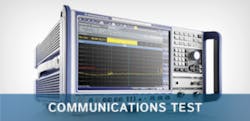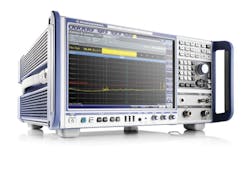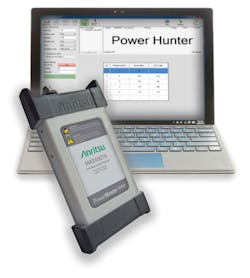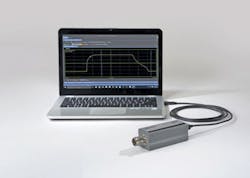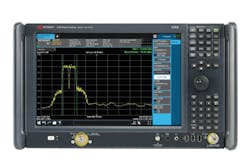Tackling challenges in the time and frequency domains
Successful product design and test increasingly call for expertise in RF/microwave, EMC/EMI, and high-speed digital technologies. Issues extend from compliance to signal and power integrity. Vendors are offering a variety of hardware and software technologies to help meet emerging design and test challenges in both the time and frequency domains. The first EDI CON USA, held Sept. 20-22 in Boston, provided an opportunity for attendees to examine the tools available to them. And European Microwave Week Oct. 3-7 in London offered an additional venue for RF/microwave test highlights.
In an EDI CON keynote session, Jin Bains, vice president for RF R&D at National Instruments, said the industrial and consumer IoTs are contributing to a Cambrian explosion of structured and unstructured data, accompanied by demands for high transmission rates, longer battery life, less latency, more devices, and higher reliability.
In the same session, Faride Akretch, marketing manager at Rohde & Schwarz, said that in pursuit of technologies like 5G, we need to learn how to test things that don’t yet exist. “Test is an integral part of every single innovation,” he said. And Todd Cutler, EEsof EDA vice president at Keysight Technologies, cited the role of simulation. Simulation and test had been separate islands, he said, but now are merging. Workflows are fundamentally changing, with correlation between the simulation and measurement worlds. “Design and test are moving together, and we need a whole new level of integration to let it happen,” he said.
On the show floor, Akretch highlighted Rohde & Schwarz’s R&S ESW EMI test receiver, which is designed for applications in manufacturers’ EMI labs and in test houses. It can carry out certification tests on modules, components, and devices as well as on systems and technical facilities in line with relevant standards, such as CISPR, FCC, and military standards. The R&S ESW (Figure 1) is suitable for conducted as well as radiated certification measurements and even meets the stringent demands placed on EMI measurements in the automotive sector stipulated by internal company standards.
Courtesy of Rohde & Schwarz
For 5G, Akretch highlighted the R&S TS-5GCS channel sounding software together with an R&S FSW signal and spectrum analyzer and an R&S SMW200A vector signal generator. The R&S SMW200A has a frequency range of up to 40 GHz and serves as the sounding signal source. The R&S FSW operates as a receiver and can be employed with various frequencies and bandwidths. The R&S FSW85, for example, enables users to analyze sounding signals up to 85 GHz without an external mixer. Adding the R&S FSW-B2000 option extends the possible analysis bandwidth to 2 GHz.
Keysight exhibited a variety of hardware and software solutions, including real-time spectrum-analysis capability for FieldFox spectrum analyzers, available in 16 models with operating frequencies to 50 GHz and real-time bandwidths of 10 MHz. Real-time spectrum analyzers can detect short-duration, bursty signals that traditional analyzers would miss, according to Cherisa Kmetovicz, product marketing engineer for FieldFox. The real-time FieldFox analyzers have 63-dB spurious-free dynamic range and can detect pulses 12-μs-wide with a 100% probability of intercept. Pulses as narrow as 22 ns can be detected with proper windowing and sufficient FFT overlap.
Keysight also highlighted its Physical Layer Test System 2016 signal-integrity software. Mike Resso, signal-integrity applications scientist at Keysight, said Version 2016 integrates new tools to boost productivity and help solve real-world problems for today’s signal integrity engineers. The latest version also includes an updated automatic fixture removal de-embedding algorithm. In addition, the company demonstrated its SIPro and PIPro software products for signal integrity and power integrity, respectively, as part of the ADS 2016 release.
Anritsu highlighted products that accurately measure high-frequency devices and systems under development for 5G as well as ones that serve military and aerospace applications. The company unveiled its Power Master MA24507A, which field applications engineer Gary Ricker called an ultraportable USB power analyzer that enables simple, numeric, frequency-based measurement of RF power from 9 kHz to 70 GHz and provides cost and performance advantages in many millimeter wave (mmWave) applications. The MA24507A (Figure 2), which Ricker called the world’s first frequency-selectable RF power analyzer, leverages Anritsu’s patented Shockline technology to address the growing number of test requirements in mmWave applications.
Courtesy of Anritsu
Wireless Telecom Group highlighted its Noisecom and Boonton brands and introduced the Boonton RTP4000 Series real-time true average power sensors. The sensors deliver a dynamic range from -60 dBm to +20 dBm, a frequency range down to 6 kHz, and a measurement rate of 100,000 measurements per second. Built with Boonton’s Real-Time Power Processing technology, which eliminates gaps in acquisition and provides zero measurement latency, RTP4000 sensors deliver fast performance in a compact USB form factor. The sensors’ true-average capabilities enable accurate capture and measurement of pulsed, modulated, and CW signals.
Boonton’s Power Analyzer Software Suite turns any computer into an RF power meter (Figure 3) with an intuitive software interface that provides a wide range of powerful measurement and advanced analysis tools. The robust API included with the software suite is suitable for leveraging the 100,000 measurements per second in remote control and ATE environments. Multiple sensors can be connected to a single computer or test system for synchronized multichannel measurements.
Courtesy of Wireless Telecom Group
National Instruments presented a variety of products but emphasized a new WiGig (IEEE 802.11ad) test solution to support multigigabit, low-latency wireless chipset development.
This demonstration at EDI CON was based on NI’s wideband mmWave transceiver technology used by leading automotive and wireless infrastructure researchers to prototype advanced radar and 5G systems. It consists of a vector signal generator and vector signal analyzer operating at 55 to 68 GHz with more than 2 GHz of instantaneous bandwidth. This new technology for 802.11ad testing also complements NI’s comprehensive product portfolio for wireless test, including existing solutions testing 802.11a/b/h/j/n/p/ac/ax, Bluetooth, GSM, UMTS, LTE/LTE-A, FM/RDS, and GNSS. NI’s Bains said, “With proposed 5G bands at 28, 38, and 73 GHz, WiGig at 60 GHz, and automotive radar at 77 GHz, mmWave is the next frontier of wideband instrument technology.”
In addition, at NIWeek 2016 in Austin, NI described a technique it called “spectral stitching,” which enables multiple vector signal transceivers (VSTs) to be chained together to expand the analysis bandwidth.1 The company also demonstrated four VSTs (each with 1 GHz of instantaneous bandwidth) combined to offer 3.5 GHz of analysis bandwidth.
Software and simulation
MathWorks highlighted Release 2016b (R2016b), adding new capabilities that simplify working with big data in MATLAB. Engineers and scientists now can more easily work with data too big to fit in memory. R2016b also has additional features in Simulink, including the capability to initialize, reset, and terminate subsystems to model dynamic start-up and shut-down behavior.
“Companies are awash in data but struggle to take advantage of it to build better predictive models and gain deeper insights,” said David Rich, MATLAB marketing director, MathWorks, in a press release. “With R2016b, we’ve lowered the bar to allow domain experts to work with more data more easily. This leads to improved system design, performance, and reliability.”
For RF and microwave applications, MATLAB and Simulink facilitate rapid and flexible algorithm exploration, design, and analysis while enabling unified simulation of digital, RF, and antenna elements. MathWorks tools enable HDL and C code generation for FPGAs, processors, and ASICs. They also support multivendor hardware and software environments for verification and prototyping.2
And in an EDI CON technical presentation, Ken Karnofsky, senior strategist, MathWorks, said new modulation schemes, new MIMO configurations, and new frequency bands are all candidates to form part of the new generation of mobile communication systems. “Joint simulation of digital, RF, and antenna behavior is needed to assess and develop these candidate technologies,” he said. He described techniques for modeling and evaluating the performance of multi-antenna and multiuser-MIMO technologies at the core of LTE, WLAN, and emerging 5G systems.
In addition, ANSYS highlighted its lineup of engineering simulation tools, including the HFSS high-frequency electromagnetic field simulation software, which features advanced solvers and leverages high-performance computing technology to support rapid design of high-frequency and high-speed electronic devices and platforms. In a technical presentation, Jim DeLap, manager, application engineering, described HFSS as part of a 3D virtual prototyping environment. The company’s goal, he said, is to support the design of something like a cell phone, including antennas, displays, and interfaces, and model it in its operating environment under all conditions.
Test instruments and systems
On the exhibit floor, companies highlighted a variety of instruments, systems, subassemblies, components, and software. Marvin Test Solutions emphasized systems, displaying its PXI-based GENASYS functional test platform and the TS-900 semiconductor test platform for mixed-signal and RF devices.
Pickering Interfaces showcased its range of PXI and LXI RF and microwave switching products along with its new two-slot USB/LXI modular chassis and LXI Simulation Tool. This new chassis offers a small, lightweight form factor, making it suitable for portable, benchtop, and space-restrictive applications. The LXI Simulation Tool provides users with a simple platform for application development.
Tektronix highlighted its DPO70000SX 70-GHz oscilloscope for signal-integrity applications. The scope employs the company’s patented Asynchronous Time Interleaving (ATI) technology. Displaying its line of USB scopes was Pico Technology, which featured its PicoScope 9000 Series sampling oscilloscopes with bandwidths to 20 GHz.
AR RF/Microwave Instrumentation presented its amplifiers, offering power ratings to 50,000 W at 1 GHz or 10,000 W at 50 GHz. One product on display was the MultiStar multitone
tester, which speeds EMC radiated immunity testing. Ophir RF also highlighted EMC, touting a lineup of high-power RF systems, line impedance stabilization networks, current probes, injection probes, transient generators, transformers, loops, and EMC transient generators and power amplifiers.
Copper Mountain Technologies displayed several of its vector network analyzers, including the patented R60 one-port reflectometer; the S5065 two-port, two-path compact series; and the CobaltFx, a new approach to mmWave frequency extension up to 110 GHz created in collaboration with Farran Technology.
Berkeley Nucleonics highlighted its phase-noise test systems, wideband receivers and real-time spectrum analyzers, and the RF/microwave signal sources, such as the Model 577 digital-delay/pulse generator with optical outputs for use in high EMI/RFI environments.
L-3 Narda MITEQ showcased its RF/microwave components, subsystems, and EMC test instruments, such as the NBM 550 broadband field meter with a data logger for electric and magnetic field measurements from RF to microwave.
EMSCAN presented its fast, magnetic, very near-field measurement tools, including EMxpert, a real-time benchtop EMC/EMI diagnostic tool, and RFxpert, which calculates far-field antenna patterns and radiated power levels based on near-field measurements.
Holzworth Instrumentation focused on its lineup of signal sources and analyzers, including the HA7062C phase-noise analyzer, which operates from 10 MHz to 20 GHz. Its 1U height makes it suitable for ATE applications. Also highlighting phase-noise analysis was Noise XT, which offers instruments including the NXA all-in-one phase-noise test system that supports RF and microwave devices from 2 MHz to 6, 26, or 50 GHz.
Colby Instruments exhibited its line of programmable delay line instruments, such as the PDL-100A, which serves in antenna and high-speed-electronics timing applications.
GigaTest Labs presented its engineering services featuring measuring and modeling high-speed connectors and cables. The company also highlighted its probe stations and probes, including the GTL microwave probe, which operates to 65 GHz. In addition, Lake Shore Cryotronics displayed its cryogenic probe stations for on-wafer probing of materials and devices, including the entry-level Model PS-100 tabletop cryogenic probe station. The company supports measurements from DC to 67 GHz.
K&L Microwave exhibited RF/microwave filters, duplexers, and subassemblies for commercial and military applications, including the CTB Series tunable bandpass filters
(Figure 4) covering ranges up to 8 GHz. The filters provide high-Q tunable solutions for higher frequency applications utilizing five-section coaxial cavity construction based on theoretical Chebyshev designs.
Courtesy of K&L Microwave
Dow-Key Microwave highlighted its line of broadband coaxial and waveguide switches operating from DC to 70 GHz, including its Reliant Switch (offering a 10 million operation life cycle with 0.03-dB insertion loss repeatability) and miniature MS-Series matrix products.
Two companies offered alternatives to test-equipment purchase. Advanced Test Equipment Rentals showed its lineup of amplifiers, oscillators, analyzers, data-acquisition products, EMC test equipment, oscilloscopes, power supplies, signal generators, and nondestructive test equipment. And Electro Rent highlighted its leasing, rental, and service solutions for a variety of applications areas, ranging from wireless research and development to load-pull and noise measurements. For the latter, Electro Rent offers equipment including the Focus Microwaves MPT-3620 harmonic tuner. In addition, Focus Microwaves was on hand with its MPT and other harmonic and wideband tuners operating from 100 MHz to 110 GHz and above.
Of course, instruments, systems, and end products need power, and TDK was on hand to exhibit its power supplies, including the recently introduced TDK-Lambda 15-W CCG15S Series DC/DC converters (Figure 5). The converters operate over a 4:1 input range and are enclosed in a 1-inch x 1-inch six-sided shielded metal case. Applications include telecommunications, broadcast, and test and measurement equipment.
Courtesy of TDK
Simulation and software
EDI CON exhibitors also emphasized software. CST presented its simulation software, including CST EM STUDIO, targeting the simulation of static and low-frequency devices. Altair Engineering highlighted its FEKO computational magnetics software, which is part of the HyperWorks suite. The software supports the EM analysis of antennas, microstrip circuits, RF components, and biomedical systems. And CapeSym highlighted its SYMMIC thermal-simulation software for analysis of transistor channel temperatures in MMICs and boards.
In addition, SiSoft presented its Quantum Channel Designer, which supports simulation of multi-Gb/s serial links, and Quantum-SI, which features integrated signal-integrity, timing, and crosstalk analysis of high-speed parallel interfaces.
And finally, COMSOL highlighted its Multiphysics integrated software environment for creating physics-based models and simulation apps. Mentor Graphics displayed its HyperLynx software for electrical signoff, with support for DDRx designs, multi-Gb/s channel analysis, 3D electromagnetic modeling, and power-distribution design.
Innovation at EuMW
At European Microwave Week 2016 in October in London, Keysight Technologies introduced the N9041B UXA X-Series signal analyzer (Figure 6). According to Mario Narduzzi, director, Communications Solutions Group Marketing, in a phone interview, this is the first analyzer to provide frequency coverage to 110 GHz with a maximum analysis bandwidth of up to 5 GHz with an external oscilloscope. Internal bandwidth is up to 1 GHz.
Courtesy of Keysight Technologies
Key applications areas, he said, include 5G and automotive radar. For the latter, challenges involve resolving small targets in dense environments. For 5G, the new instrument can help meet challenges presented by the massive growth in mobile data demand and the number of connected devices as well as the exploding diversity of wireless applications.
Narduzzi said the N9041B UXA exemplifies the company’s unique capabilities with attributes such as advanced front-end indium-phosphide circuitry. This achieves low loss and efficient mixing, providing a displayed average noise level as low as -150 dBm/Hz when characterizing wideband modulated signals in the mmWave band.
You can expect more innovations to roll out in the areas of RF/microwave, EMC, and high-speed digital test. For example, DesignCon, scheduled for Jan. 31-Feb. 2 in Santa Clara, will offer an opportunity to present the latest in high-speed digital test.
References
- Nelson, R., “With spectral stitching, VSTs team up to extend analysis bandwidth,” EE-Evaluation Engineering, Rick’s Blog, Aug. 3, 2016.
- Nelson, R., “MathWorks targets next-generation wireless design at IMS,” EE-Evaluation Engineering, Rick’s Blog, May 31, 2016.
For more information
- Advanced Test Equipment Rentals
- Altair Engineering
- Anritsu
- ANSYS
- AR RF/Microwave Instrumentation
- Berkeley Nucleonics
- Boonton
- CapeSym
- Colby Instruments
- COMSOL
- Copper Mountain Technologies
- CST
- Dow-Key Microwave
- Electro Rent
- EMSCAN
- Focus Microwaves
- GigaTest Labs
- Holzworth Instrumentation
- K&L Microwave
- Keysight Technologies
- L-3 Narda-MITEQ
- Lake Shore Cryotronics
- Marvin Test Solutions
- MathWorks
- Mentor Graphics
- National Instruments
- Noise XT
- Ophir RF
- Pickering Interfaces
- Pico Technology
- Rohde & Schwarz
- SiSoft
- TDK-Lambda
- Tektronix
About the Author

Rick Nelson
Contributing Editor
Rick is currently Contributing Technical Editor. He was Executive Editor for EE in 2011-2018. Previously he served on several publications, including EDN and Vision Systems Design, and has received awards for signed editorials from the American Society of Business Publication Editors. He began as a design engineer at General Electric and Litton Industries and earned a BSEE degree from Penn State.
